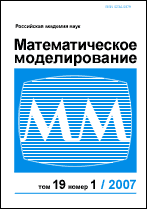|
This article is cited in 9 scientific papers (total in 9 papers)
DiMP-Hydro solver for direct numerical simulation of fluid microflows within pore space of core samples
V. A. Balashov, E. B. Savenkov, B. N. Chetverushkin
Keldysh Institute of Applied Mathematics of RAS, Moscow
Abstract:
The paper is devoted to the description of the software package DiMP-Hydro, being developed in Keldysh Institute of Applied Mathematics (Russian Academy of Sciences). It is intended to simulate microflows of single- and two-phase viscous compressible fluids with different rheology in spatial voxel domains. Such geometric models are relevant due to development and widespread usage of computer microtomography methods. One of the main areas of application of this software package is the simulation of microflows within pore spaces of core (rock) samples. Simulation results can be used to determine macroscopic properties of core samples (for instance, absolute permeability) and features of displacement processes at the micro level, which is one of main tasks of the “digital rock” technology. The description of the used mathematical models, numerical algorithms and the software package is given. To describe the fluid dynamics, the regularized Navier–Stokes (for single-phase flows) and Navier–Stokes–Cahn–Hillard equations (for two-phase flows) are used. The regularization is based on the quasihydrodynamic approach, which is physically justified and makes it possible to use explicit stable numerical algorithms that are relatively simple to implement. The software package is parallel and focused on the use of high-performance computing systems. The results of the use of DiMP-Hydro for simulation of microflows of fluid (including twophase) and gas (including moderately rarefied) in the pore space of core samples are presented.
Keywords:
microflows, software package, digital rock physics, quasi-hydrodynamic regularization, Navier–Stokes–Cahn–Hillard equations.
Received: 18.10.2018
Revised: 18.10.2018
Accepted: 19.11.2018
Citation:
V. A. Balashov, E. B. Savenkov, B. N. Chetverushkin, “DiMP-Hydro solver for direct numerical simulation of fluid microflows within pore space of core samples”, Matem. Mod., 31:7 (2019), 21–44; Math. Models Comput. Simul., 12:2 (2020), 110–124
Linking options:
https://www.mathnet.ru/eng/mm4093 https://www.mathnet.ru/eng/mm/v31/i7/p21
|

|




 Contact us:
Contact us: Terms of Use
Terms of Use
 Registration to the website
Registration to the website Logotypes
Logotypes








 Citation in format
Citation in format 
